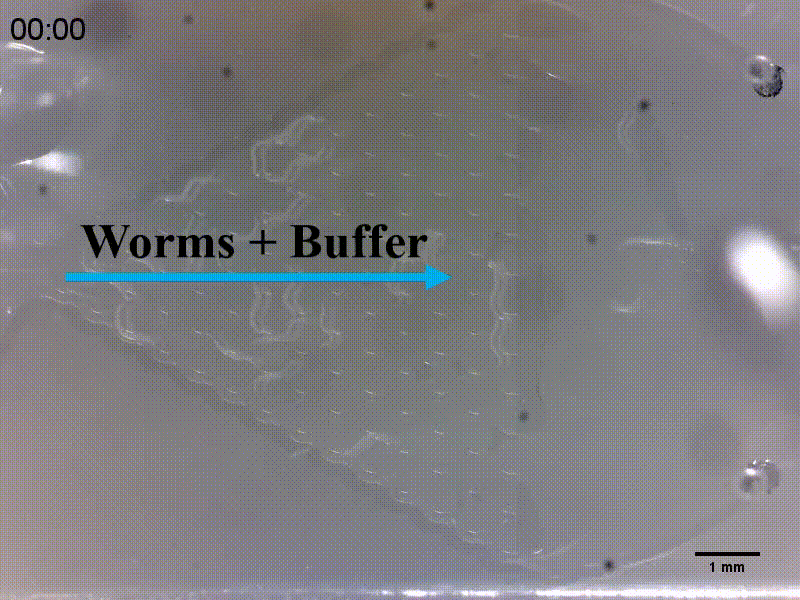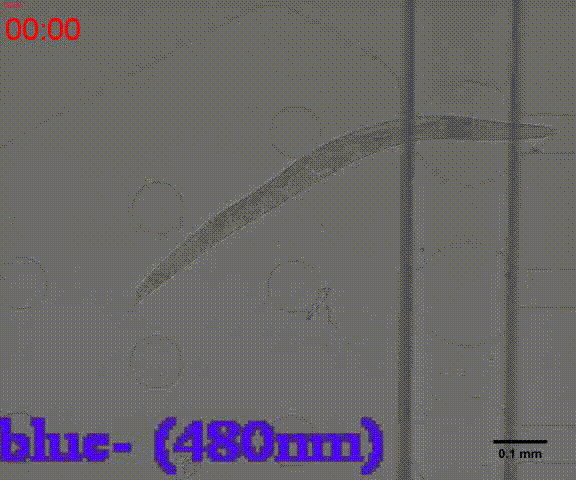Demonstrate
Project
Contents
Overview
So far, our project has been almost completed. The whole project is demonstrated in the following parts:
1.Optogenetic results of spectrum determination
2.Microinjection results
3.Neuron activation
4.Behavior experiment (including single worm and population)
5.Addiction inducing results
Spectrum determination
The channelrhodopsins we chose in our project were evolved from the algae, so if we applied these light sensitive channel to the Caenorhabditis elegans as the receptors, we need to check its optical parameters before our behavior experiment. The spectrum of Chrimson and CoCHR have been already measured by other scientists. With the spectrums of two channelrhodopsins, we need to figure out the another two questions :crosstalk and indicator spectrum.
The first question is that whether the channelrhodopsin CoCHR will have the wavelength crosstalk with the indicator protein—GEM-GECO , the excitation wavelength of CoCHR is crossed with the emission wavelength of activated GEM-GECO combined with calcium, which means that we can not activate CoCHR and receive GEM-GECO emission fluorescence in the same time with same wavelengths because of the filter. So we have to do the experiment based on the cell to select another suitable excitation wavelength for CoCHR.

The excitation and emission wavelength are the most important parameters for all kinds of optical protein, so if we want to know what happened inside the worms’ neuron after light induing, the spectrum of indicators expressed in the C.elegans must be figured out. So we use the sensitive detector to receive the emission wavelength from the C.elegans AWA neuron after activated by diacetyl inducing. Then we analyze the emission data and select the best two wavelength area for the indicator emission wavelength with and without calcium existing. This part will be shown in the neuron experiment.
System construction in C.elegans
In order to select the worms stable transacted with the system we have constructed, we design a series selection experiments for verification. These figures showed that the result of the selection process using the fluorescence marker selection ,the rescue selection and the negative poison selection. We then do the mapping for the genome of the worms to check the insertion of the system. Finally we use confocal microscope to check the location marker to test the expression of the whole system.

Activation of C.elegans head neurons
Since the whole system has expressed in the C.elegans, we need to check the function of each part in our project. So we have done many experiments on the head neuron of the worms, we first check the function of the GEM-GECO.
These figures showed the position and the reaction of AWA neuron which expressed GEM-GECO after diacetyl inducing.
Microfluidics
In order to study locomotion of C.elegans populations, we design the Gaussian Chip, a pillar-filled area, where the pillars were designed such that they allow crawling-like behaviors of C.elegans even though worms are immersed in liquid environment.


Response to light (Individual)
To verify the response to specific wavelength light inducing, we picked out a single worm to observe the behavior change.
Alcohol addiction
To verify the function of the system we constructed in the C.elegans and give our project a real word meaning, we design this experiment to train the C.elegans be addicted to alcohol.
If our system worked and can control the worms prefer to alcohol after blue light (preference) trained, it can prove that all the function we purposed for this system has been already realized.
Here, we employ the Odr-10::CoChR::GEM-GECO::mCherry worms to measure the preference for the alcohol. We added the alcohol with different concentration on the NGM plate to form a liquid film to stimulate the C.elegans and give the worms blue light induced which is proved can make them show a preference. After 2 hours we washed the plate to recover the worms in M9 buffer and put the mixture (contained worms and M9 buffer) on one side of a new plate. After recovery of the worms, we put the alcohol on the other side of the same plate to find out if the worms have the tropism of the alcohol.
Then we observed that the Odr-10::CoChR::GEM-GECO::mCherry worms could move to the alcohol while the wild types could not (Fig.8). And both of the experimental worms and wild type worms show no response to the buffer after training.By the same time, the Odr-10::CoChR::GEM-GECO::mCherry worms show no response if we do not train the with the blue light.


This experiment showed that our worms which constructed the circuit (specific promoter::channelrhodopsin::Calcium indicator) can form the habit we purposed after trained with the light (decided by the channelrhodopsin). In brief, we have proved that our experimental worms have the learning ability inducing by light. Thus, the goal of our experiment has been almost achieved. We get the worms controlled by the light and the neuron activity can also be traced by observing the change of the indicator.
Future Plan
In the future, we will track the neuron activity and do the alcohol inducing at the same time on the Odr-10::CoChR::GEM-GECO::mCherry worms after 2 hours training. By the time, we will build a model to select the downstream neuron of the AWA/AWB neurons and then using the specific promoters of these neurons fused with indicator to verify the relationship between them.Then finally we will figure out the whole neuron network of the learning ability, we can do the simulation on wherever we like to test the network, and we can know the logical order of the neurons when a new ability formed.






